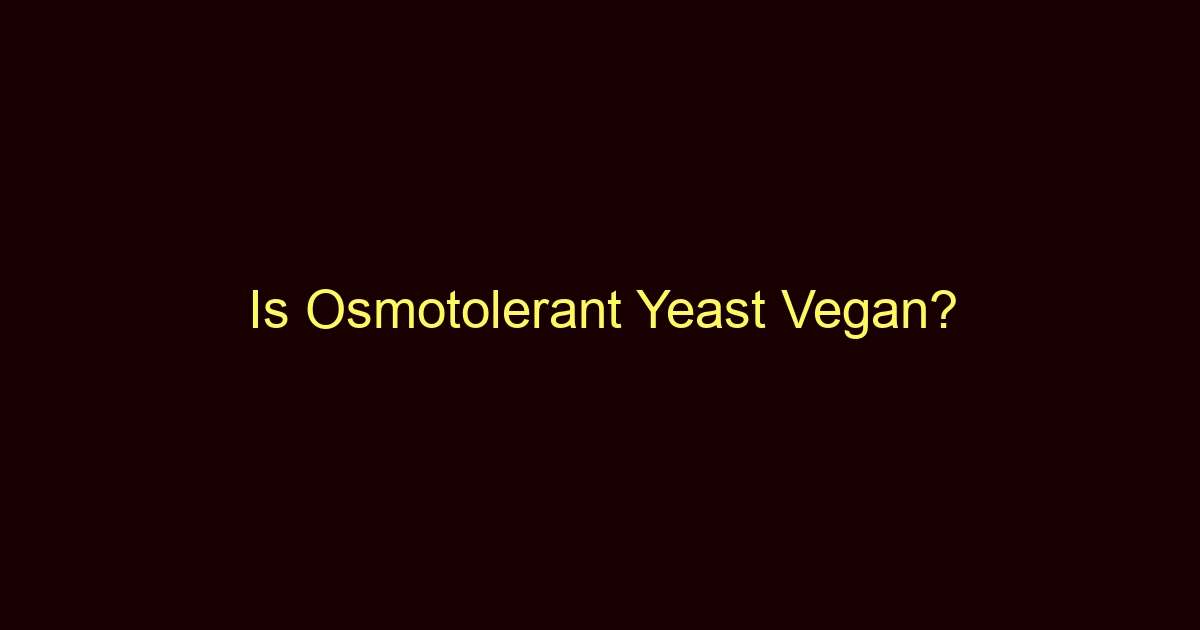Osmotolerant yeast is a powerhouse in the world of baking, bringing unique properties that make it indispensable in many recipes. However, when we choose veganism, there are lots of ingredients we need to reconsider, and yeast is one of them. Let’s dive deep into understanding osmotolerant yeast and find out if it is compatible with a vegan lifestyle.
What is Osmotolerant Yeast?
Osmotolerant yeast is a specific kind of yeast that’s adapted to thrive in high-sugar environments. Regular yeast strains may struggle or slow down their fermentation activity when faced with high sugar concentrations, but not osmotolerant yeast. This little microscopic organism powers through, giving us beautiful, well-risen bread even in the sweetest of doughs.
This strain of yeast, such as Saccharomyces cerevisiae, is commonly used in the baking industry, especially in the production of sweet bread, pastries, and other baked goods that have high sugar content. The ability of these yeasts to withstand osmotic pressure in sugary environments without compromising their leavening ability is quite remarkable.
What is Osmotolerant Yeast Made of?
Like all yeast, osmotolerant yeast is a type of fungus. It’s a single-celled organism that reproduces by budding. Osmotolerant yeast strains, such as Saccharomyces cerevisiae, have adapted over time to be able to withstand high sugar concentrations that would dehydrate and slow down other yeast strains.
Osmotolerant yeast strains are produced commercially through fermentation processes. They are grown in large fermentation vats in a nutrient-rich growth medium. Once the yeast has multiplied to the desired level, it’s harvested, processed, and dried before it’s packaged and distributed.
What is Osmotolerant Yeast Used For?
Osmotolerant yeast is most commonly used in baking, particularly in doughs with high sugar content. While regular yeast can be inhibited by the osmotic pressure created by high sugar levels, osmotolerant yeast is able to continue fermenting and raising the dough.
This makes it perfect for baking sweet bread, pastries, and other sweet baked goods. It’s also used in certain traditional bread recipes that call for higher sugar content.
What Foods Contain Osmotolerant Yeast?
Osmotolerant yeast is commonly found in baked goods, especially those with high sugar content. This includes sweet bread, pastries, cakes, and certain types of traditional bread. It’s also found in some fermented beverages.
Is Osmotolerant Yeast Vegan?
Yes, osmotolerant yeast is vegan. Yeast, including osmotolerant strains, are single-celled organisms classified as fungi. They do not belong to the animal kingdom, so their use is generally considered acceptable in a vegan diet.
Moreover, the process of producing commercial yeast does not typically involve any animal products or byproducts. However, it’s always a good idea to check the packaging for any additional non-vegan ingredients or additives.
Can Vegans Eat Osmotolerant Yeast and Why?
Yes, vegans can eat osmotolerant yeast. As a type of fungus, yeast is a plant-based ingredient and doesn’t involve the use of animals in its production or processing. Therefore, it’s perfectly suitable for those following a vegan lifestyle.
It’s worth noting that while the yeast itself is vegan, not all foods made with it may be. For instance, a sweet bread made with osmotolerant yeast may still contain eggs, milk, or butter. As always, it’s essential for vegans to check all the ingredients in a product, not just the yeast.
Benefits and Downsides of Osmotolerant Yeast
Osmotolerant yeast offers numerous benefits, particularly in baking. It allows for consistent rising in doughs high in sugar, where regular yeast strains might falter. This gives bakers the ability to create a wide variety of sweet breads, pastries, and other treats.
However, as with all types of yeast, it’s possible for some people to have allergic reactions to osmotolerant yeast. Symptoms can range from mild (such as bloating or indigestion) to severe (like skin rashes or breathing difficulties). If you suspect you have a yeast allergy, it’s important to consult with a healthcare professional.
Osmotolerant Yeast in Baking
In baking, osmotolerant yeast is a game-changer. It can tolerate high sugar environments where ordinary yeasts would fail. This means it’s possible to create a variety of sweet doughs, from donuts to babkas, without worrying about the yeast’s ability to leaven the dough.
The process remains the same as using regular yeast. The yeast is first activated in a warm liquid and then mixed with the rest of the ingredients. Then, the dough is allowed to rise, shaped, and finally baked.
Is Osmotolerant Yeast Safe?
Yes, osmotolerant yeast is safe to consume and is used extensively in the baking industry. As with all food products, it’s important to consume it as part of a balanced diet.
However, some people may have allergies or sensitivities to yeast, which could cause various symptoms. If you suspect you have a yeast allergy, it’s important to consult a healthcare professional before consuming products containing osmotolerant yeast.
Final Thoughts
Osmotolerant yeast is vegan-friendly. As a type of fungus, it’s a plant-based ingredient and its production does not involve the use of any animal products or byproducts. It’s a powerful tool in the baking world, especially when it comes to making sweet breads and pastries.
However, while the yeast itself is vegan, it’s important to remember that not all products made with it may be. Some breads and pastries might still contain dairy or eggs. Therefore, it’s always a good idea to check the label or ask the baker if you’re purchasing a finished product.

